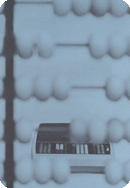From the First Desktop to the First PC:
If the HP test instrument history is not a widely covered subject on the web and on other media, the same cannot be said for the HP computer history. A lot has already been written on the subject, and a lot of information and history is already available on the web. By far the best web site about the "prehistoric times" of HP computers is by Steve Leibson . Steve gives us an in-depth insight into HP's early computers and the pioneers who developed them. Compared to Steve's thorough work, what you will find below is just a summary of the HP Desktop Calculator production from 1968 to 1980. But as usual, the chapter is illustrated by photo of the devices and documents available in our collection.
1968, HP 9100A, The World's First Desktop Calculator
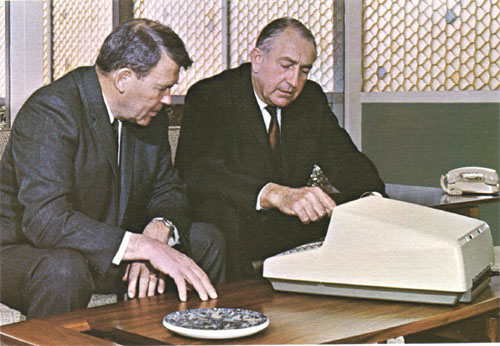 |
Bill Hewlett (left) with Dave Packard Operate the HP 9100A Desktop Calculator, Developed by HP Labs
Photo from the 1968 Annual Report,
Courtesy of the Hewlett Packard Company |
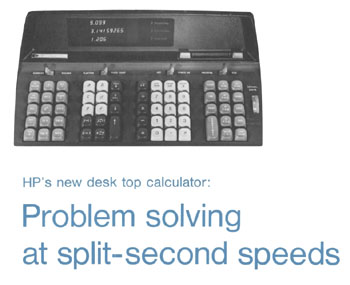 |
The HP 9100A in the March 1968 MEASURE Magazine
Courtesy of the Hewlett Packard Company
|
Problem Solving
at Split-Second Speeds
With the 1968, March 11 conference at New York City's Waldorf-Astoria Hotel, the press had the whole story. There, with representatives of the nation's business and technical magazines and newspapers in attendance, the HP Model 9100A was presented. A report of this event was made in the March 1968 issue of MEASURE Magazine with the following introduction:
"Hewlett-Packard officials today announced the development of a selfcontained electronic calculator the size of a typewriter.
It can, they reported, outperform many computers.
In making the announcement, Board Chairman David Packard said the calculator was developed primarily for scientists and engineers, to speed and simplify their complex calculations. He said it is also expected to find wide use in education and in those areas of business involving higher mathematics.
"With the rapid growth of science and technology has come an increasing need for easily operated, attractively priced calculating machines that will perform a broad range of mathematical operations at split-second speeds," Packard said.
"Another requirement of these machines is that they be programmable, like computers, to solve complicated problems. In meeting these objectives, the new Hewlett-Packard 9100A desktop calculator exceeds all other calculators on the market today.
"It was more than two years in development, and represents something of a departure from our traditional product line," he added.
Outlining specific features of the calculator, Dr. Bernard M. Oliver, HP's vice president for research and development, pointed out that the instrument's keyboard includes all the functions commonly found on the engineer's slide rule. Among these are logarithms, exponentials, hyperbolic and trigonometric functions and the inverse of these, as well as coordinate transformations. He pointed out that it's as easy to transfer a vector to polar form as it is to add two numbers.
"We believe one of the most interesting and popular uses of the calculator will be in teaching math to students," Oliver said. "By removing the time-consuming drudgery of manipulating numbers and consulting tables, the calculator will enable the student to concentrate on the pure principles of mathematics and thereby enhance his learning process."
The HP 9100A, Another "Invention of Opportunity"
In his book: "Inventions of Opportunity" Bill Hewlett summarizes the Model 9100 Project:
"...a new project took its place in HP Labs to develop a powerful desktop electronic calculator. We were approached by a young inventor who had perfected a simple four-function calculator of practical design using reverse Polish notation. At about the same time, a technique for achieving single-key transcendental functions also was brought to our attention. The question: Can the two technologies be made to work together? The answer: Yes, and a formal development project was initiated. This was a formidable program, for not only were the technical problems pioneering and difficult, but as this calculator was to be used for general scientific work, often by customers unskilled in computer operation, it had to be well-styled, "friendly," and easy to use. This obviously was a major problem, and ultimate manufacturing responsibility was assigned to our division in Loveland, Colorado. Engineers from Loveland came to Palo Alto and worked hand in hand with engineers in HP Labs to complete a prototype unit, thus insuring that the transfer to Loveland would be achieved without difficulty. Within two years, the project was completed and the unit in production. There are four articles which discuss various aspects of this program. I particularly call your attention to Barney Oliver's article, "How the Model 9100A Was Developed," one of several articles about the calculator in the September 1968 HP Journal..."
Barney Oliver Analysis of the 9100 Project
Quoted above by Bill Hewlett, R&D Vice President Barney Oliver discusses the HP Model 9100 project in the September 1968 Hewlett-Packard Journal. The reading of this page gives a measure of the motivation generated inside the various divisions who contributed to the Model 9100 project.
 |
Some lab projects are endothermic: the desired reaction proceeds only with the application of considerable heat and pressure and stops the moment these are relaxed. Others are exothermic: when the proper ingredients are brought together the reaction starts automatically and it is only necessary to harness and control the power that is generated. The 9100A project was one of the most exothermic I have known.
The ingredients started coming together in the late summer of 1965 when we were shown a prototype of a calculator invented by Malcolm McMillan that had one interesting feature: it could calculate all the common transcendental functions. The machine operated in fixed point and took a few seconds to calculate a function, but it did demonstrate the feasibility of providing these functions in a small calculator, and the power of the algorithm used to compute them.
The second ingredient was Tom Osborne who came to see us carrying a little green balsa wood calculator, which he had built on his own to demonstrate the virtue of some of his design concepts. What impressed us was its millisecond speed and its ten digit floating point operation and display.
A third ingredient was the imagination of Paul Stoft and other engineers in his group. It took no genius to see the appeal of a calculator that combined the speed and dynamic range of Tom's machine with the transcendental computing ability of the other machine. But to combine them into a small machine faster than either prototype, to adapt the transcendental algorithm to floating point, to add programmability and magnetic card storage and entry of programs, to provide the flexible display with automatic roundup, and to design the whole assembly for automated production required not only imagination but engineering skill of the highest order.
Another ingredient, the read only memory, which stores all the calculating and display routines, was already under development by Arndt Bergh and Chuck Near before we began the 9100A project. By carrying printed circuit techniques beyond the existing state of the art, Chuck was able to compress the required 32,000 bits into an amazingly small space. While the 9100A uses only discrete diodes and transistors, it it fair to describe the read only memory as one large integrated circuit with extremely long life expectancy.
As soon as the development began, everyone, it seemed, had ideas for new features. Hardly a day went by without someone proposing a new keyboard with a new key arrangement or new functions. It was Dick Monnier's responsibility as section leader to steer the project through these conflicting currents of ideas. Although we went down a couple of blind alleys, for the most part the course was held true. That we arrived at such an elegant solution in a short time is a tribute to Dick's navigation.
Tom Osborne joined the development team as a consultant on the general architecture of the machine. His contributions include the basic logical design, and the details of the control logic, flip-flops, mother board gates, and the memory drive and sense circuitry. He also contributed a large measure of sound judgment that resulted in an economy of design, low power consumption, high performance, and the ability of the 9100A to interface with peripherals and systems.
Tony Lukes developed the display routines, which include the features of automatic roundup in fixed point display, choice of decimal places, suppression of insignificant zeros, and the display of program step addresses and key codes, as well as numerical data. Tony also developed the program storage, editing, and execution routines which, together with the display, make the 9100A easy to use and program.
I should at this point emphasize that the 9100A, while small, is, in a sense, much more complicated than many general purpose computers. Most general purpose computers have relatively large memories but can execute directly only certain elementary machine instructions. To compute complicated functions and indeed, in some cases, even to perform simple arithmetic, the computer must be externally programmed.By contrast the 9100A has a very sophisticated external instruction set: the entire keyboard. The 9100A is a small computer with a large amount of 'software' built in as hardware. |
The task of compressing the floating point arithmetic operations and functional computations into the limited read only memory of the 9100A was accomplished by Dave Cochran. To make sure that all the calculations were accurate over the enormous range of arguments allowed by the floating point operation, to assure exact values at certain cardinal points, and above all to get so much in so little memory space was an enormous achievement.
I sometimes wonder if Dave realizes what a remarkable job he did. It took several passes. On the first pass it appeared hopeless to include all the functions. But by nesting routines and by inventing a number of space saving tricks he was able to save enough states to crowd them all in. Then various bugs were discovered and more states had to be freed to correct these. The 'battle of the states' continued for several months and the end result was one of the most efficient encoding jobs ever done.
The necessity for magnetic card program storage and entry became apparent as soon as we had an operating prototype. Don Miller, Dick Osgood and Bob Schweizer deserve praise for the speedy development of this unit, which adds so much to the convenience of the 9100A.
Clarence Studley supervised the overall mechanical design and assembly, reducing to manufacturing drawings and to the final metal the handsome cabinet styling of Roy Ozaki, Don Aupperle and others in the Industrial Design group, while Harold Rocklitz and Doug Wright handled much of the tooling.
Many other people contributed to the 9100A — too many to give proper credit to all; but I must mention the fine art work of Frank Lee on the read only memory and other printed circuit boards, Chung Tung's work on the core memory electronics and Bill Kruger's development of the short high brightness cathode ray tube. Chris Clare made many contributions to the project especially in the area of interfacing the calculator with printers and other peripherals. A special measure of recognition is due Ken Petersen whose expert technicianship and whose genius at trouble shooting saved us weeks of time and bailed us out of many tight spots. Ken also laid out the multilayer mother board with its thousand diode gates and interconnections.
The transfer of the 9100A from Hewlett-Packard Laboratories to the Loveland Division took place gradually rather than abruptly. As various portions reached the final prototype stages, responsibility for these was assumed by the Loveland group headed by Bob Watson in engineering and by Jack Anderson in production. Many visits both ways and some transfer of people to Loveland accomplished the transmission of much unwritten information. The Loveland team introduced several engineering improvements. Especially significant were the improved read only memory margins obtained by Rex James and the many contributions by Ed Olander, whose comprehensive understanding of the entire machine helped greatly. That we were able to go from an incomplete lab prototype stage in Palo Alto to a pilot run of final instruments in Loveland in only 10 months attests to the skill and dedication of the Loveland group and to the fine cooperation on both sides.
Finally, I must confess that very few projects receive as much direct attention from corporate management as this one did. Early in the spring of 1967 a skiing injury landed Bill Hewlett in the hospital. We learned about this right away when he called up to have some 9100A programming pads sent over. I found myself hypnotized by the project and unable to share my time equitably. Here was management in the unusual role of consumer, for if Bill and I did anything constructive it was mainly to assess and modify the developing product from the user's standpoint. I owe the 9100A group an apology for being constantly in their hair, and everyone else in HP Labs an apology for slighting their projects. Now that it's all over I find the 9100A as fascinating to use as it was to develop. Caveat emptor! |
 |
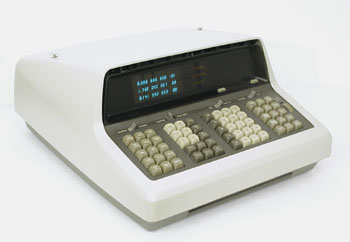 |
The HP 9100B Calculator
|
The HP 9100 Computing Calculator
The model 9100A was introduced in the September, 1968, Hewlett-Packard Journal and appeared for the first time in the 1969 catalog, page 130 with the following description:
The 9100A is a programmable, electronic calculator which performs operations commonly encountered in scientific and engineering problems. Its log and trig functions are each performed with a single key stroke, providing fast, convenient solutions to intricate equations. Computer-like memory enables the calculator to store instructions and constants for iterative solutions. The easily-readable cathode ray tube instantly displays entries, answers and, when desired, intermediate results.
Direct keyboard operations include: Arithmetic, Logarithmic, Trigonometric, Hyperbolic and Coordinate transformation. Decimal point is selectable, fixed or floating-point notation for display of entries or answers. A decimal wheel selects 0-9 decimal places, with automatic rounding to the number of places selected.
Magnetic core memory contains 19 registers: 3 displays registers (keyboard, accumulator, temporary) and 16 storage registers, with store/retrieve controls. These registers may be used to store 16 constants, or 196 program steps plus 2 constants, or a combination of constants and program steps. The read-only memory contains over 32,000 bits of fixed information for keyboard routines.
Programming: The program mode allows entry of program instructions, via the keyboard, into program memory. Programming consists of pressing keys in the proper sequence, and any key on the keyboard is available as a program step. Program capacity is 196 steps. No language or code-conversions are required. A self-contained magnetic card reader/recorder records programs for program memory onto wallet-size magnetic cards for storage. It also reads programs from cards into program memory for repetitive use. Two programs of 196 steps each may be recorded on every reusable card. Cards may cascaded for longer programs.
Speed: Maximum times for total performance of typical operations, including decimal-point placement:
Add, substract: 2 milliseconds. Multiply: 22 milliseconds. Divide: 27 milliseconds. Square-root: 30 milliseconds.
Sin, cos, tan: 330 milliseconds. ln x: 130 milliseconds. Coordinate transformation: 280 milliseconds.
It is interesting to note that computer performance of this size was state-of-the-art just one year before the first moon landing.
Price: $4900. (Average cost of a new car in the USA in 1968 was $2800)
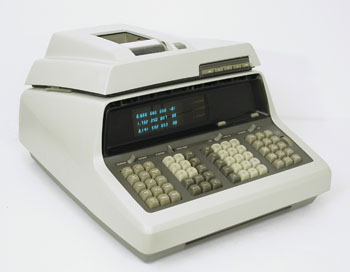 |
The HP 9100B Calculator with 9120A Printer
|
The 9100, Versions & Accessories
The HP 9100A was introduced first in 1968 with maximums of 16 storage registers and 196 program steps.
The HP 9100B, in 1970 doubles this capacity with maximums of 32 storage registers and 392 program steps. On both machines, core was shared between registers and program steps. (The 9100B had two pages of core.) The HP 9100B also added subroutines, a dual program display, and a key to recall numbered registers into X.
The HP 9101A Extended Memory, was introduced in the 1971 catalog supplement. It is a rack mountable box of core memory providing an additional 3472 program steps or 248 data registers. This option could be added to either model.
The Model 9120A Printer, shown on the above photo, attaches to the top of the calculator. It was introduced in late 1969 for use with the 9100A and remains compatible with the 9100B version. The 9120A, electrostatic printer, prints the contents of display registers X, Y, Z, singly or in any combination, upon manual or programmed command.
HP 9800 Series, The Second Generation
Entering the desktop computer business in 1968 with the HP 9100 described above, HP had only a single product offering until 1971. With the introduction of the HP 9810 in 1971, and then the 9820 and 9830, both in 1972, their offering quickly turned into a complete product line. These second generation products spawned the development of HP's Loveland and Fort Collins Colorado divisions, which gave birth to many innovations in desktop technical computing in the 1970s and 1980s.
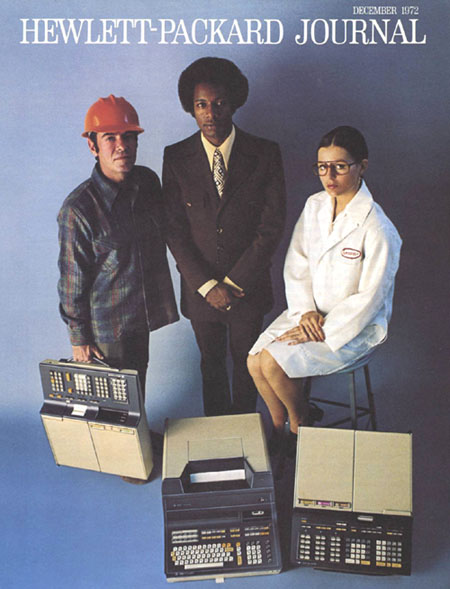 |
Cover of the December 1972 issue of the Hewlett Packard Journal
Courtesy of the Hewlett Packard Company |
Three Models, HP 9800 10 / 20 / 30,
Three Calculators in the 9800 Series. Model 10 was a key-per-function calculator with a keyboard and language that were extensions of the HP 9100A/B. Model 20 had a statement-oriented algebraic language with a natural input of arithmetic expressions, including parentheses. Model 30 was even more interactive, being the first to include a typewriter-like alphanumeric keyboard. The programming language of the Model 30 was BASIC, an already well-known and easy-to-learn computer language.
 |
Comparing 9800 Series Calculators - December 1972 issue of the Hewlett Packard Journal
Courtesy of the Hewlett Packard Company |
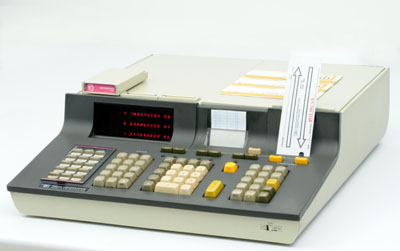 |
HP 9810
|
The HP 9810
The 9810A was HP's second generation RPN calculator. It was introduced as the successor of the 9100A/B, maintaining compatibility, and expending capability of its predecessor.
Instead of a CRT, the 9810A had a three-line LED display. It was also upgradable with ROM modules to perform additional functions (math functions, peripheral I/O, etc).
The 9810A had a built-in card reader allowing the use of longer cards with increased storage capacity beyond those used in the 9100A/B. Unlike the 9100 which had a single expansion slot, the 9810A had four expansion slots in the rear of the machine, and an optional 16-character, internal thermal printer.
A number of innovations to the desktop computer market, were brought about by the 9800 series. Among them are the following:
- Plug-in, solid-state function ROM on the Model 10
- 16 - character alpha numeric LED display on the Model 20 and 30
- Built-in tape cassette for the Model 30 mass-storage
- Teleprinter-like keyboard and BASIC Programing language on the Model 30
More importantly, the 9800 series desktop computer was the first to integrate a versatile input / output structure to link the computer to a variety of peripherals. A limited choice of peripheral dedicated to computing. Plotter, printer, mass-storage took place in the HP catalog for the first time . . .
. . . Some promising new markets.
 |
From October 1971 MEASURE Magazine
Courtesy of the Hewlett Packard Company |
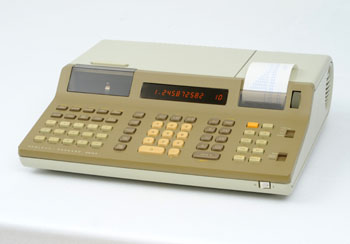 |
HP 9815A
|
The HP 9815
The 9815A could be considered as the last pure calculator in the HP product lines. It was the last one to use a calculation dedicated keyboard. Every following desktop would have typewriter-like, ASCII keyboard.
But despite this, it was a significant improvement on the 9800 computers. It had a lower cost than the previous machines and was also much smaller and lighter. The 9815A was presented in the June 1976 issue of the Hewlett Packard Journal as the replacement of the HP 9810A with the benefit of 5 years of technology advances.
One of these main advance was the use of a new DC-100 mini-cartridge tape mass storage system made by 3M which provided 94K of storage space. The 9815 also had a built-in 16-character thermal printer and two optional I/O expansion slots. Interfaces available for the 9815A included special interfaces for the 9862A Plotter and the 9871A Printer, and four general interfaces: 8-bit I/O, BCD, HP-IB, and RS232C.
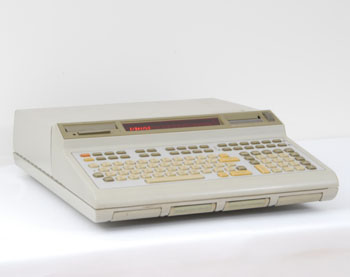 |
The HP 9825
|
The HP 9825
As we recommended in the introduction of this chapter, the place to go for in-depth treatment of the 9825's history, is Steve Leibson's Web site.
On his web site "The Story of the Little Computer that Could," Steve introduced the HP 9825A as a computer which was a way before its time, and marking a significant turning point for the computer industry with the following innovations:
" The HP 9825 had a 16-bit, HP-designed, HP-fabricated microprocessor when the “real” semiconductor industry was producing 8-bit toy microprocessors and years before the major microprocessor vendors could produce anything similar.
At a time when microcomputers stored data as audible tones on analog audio cassettes, the HP 9825 stored programs and data on a revolutionary digital miniature tape cartridge that launched the entire microcomputer tape-backup industry.
The HP 9825 booted directly from ROM into an operating system that was ready to go in two seconds while minicomputers and the crude microcomputers of the day required that boot loaders be toggled by hand so that the machines could then load paper tapes containing their programs.
Perhaps, most important of all, the HP 9825 set a new standard for the control of a wide range of peripherals and instruments that would not be matched for many years."
The 9825 was HP's first HPL (High-level Programming Language) computer. It replaced the 9820. The 9825 had a full QWERTY keyboard and three expansion slots at the rear of the machine. The 9825 also had a live keyboard which enabled the user to type while the computer was executing other functions. Other built-in features included a 16-character thermal printer and a 248K mini-cartridge tape drive.
Introduced in 1976, The 9825 was obsoleted in May of 1985.The 9825 was a very successful product for HP. In October of 1980, the company built the 25,000th 9825. 17,000 had been built in Loveland/Fort Collins, and the other 8,000 units had been manufactured in Boeblingen, Germany.
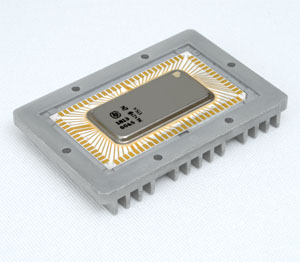 |
The HP 9825, NMOS LSI Processor
|
The 9825 Processor
The heart of the 9825A is an HP-developed 16 bit processor. It consists of three N-channel metal-oxyde-semiconductor (NMOS) large-scale integrated (LSI) circuits, and four bipolar chips in a hybrid circuit on a 7.6 x 3.8 cm ceramic substrate. This substrate is mounted on an aluminium die cast heat sink to keep the surface of the LSI chips at less than 70 ° while dissipating six watts in the processor. (photo on the right)
A block diagram of the processor is shown below. The three LSI circuits have the following functions: The primary chip is the Binary Processor Chip (BPC) which executes 59 instructions. The 12-instruction IOC controls input and output functions. The Extended Math Chip (EMC) executes 15 instructions, mostly for mathematical routines.
Each processor chip has an internal control array approximately equivalent to an 8000-bit ROM. Also on the average, about 6000 MOS transistors, or 2000 equivalent gates, are contained on each LSI chip. ( This was called LSI in 1975 )
The performance of this processor was such that it had no competitor on the microprocessor market of the time. Top product from Intel in 1974 was the 8080 with 4500 transistors, but its architure was not so "I/O performance" oriented. The particular design of the 9825 processor was so well suited to the calculation and data manipulation problems found in system automation, that it was integrated in the first HP automated instruments. For example the same processor was the heart of the 8568A Automatic Spectrum Analyzer introduced in 1977.
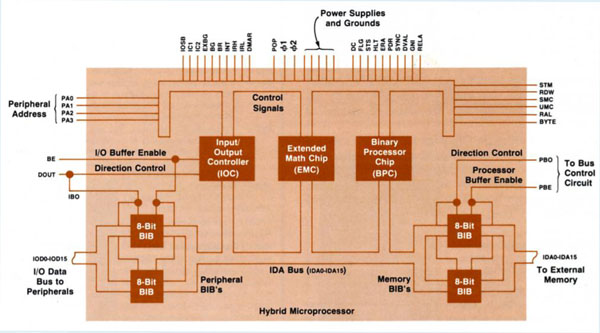 |
Block Diagram of the HP 9825, NMOS LSI Processor
Courtesy of the Hewlett Packard Company |
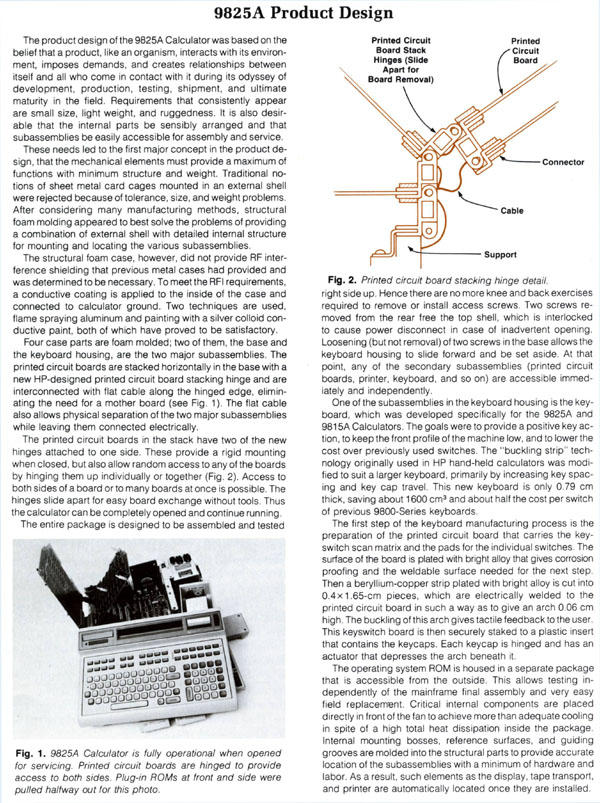 |
The HP 9825A Product Design, from the June 1976 Hewlett Packard Journal
Courtesy of the Hewlett Packard Company |
Animation Display: Interior Panoramic View of the HP 9825
Animation |
 |
|
HP 9825 a High Performance System controller
Above all, the 9825 was the first high performance bus manager. The first conductor of the HP-IB orchestra. An orchestra already boasting tens of instruments in 1976, but an orchestra with an incredible growth rate. During its ten year reign, the 9825 would see the quantity of HP-IB compatible instruments rising to several hundreds. Purpose designed to be an instrument controller, the performance of the 9825 would be sufficient to support the technology changes up to the mid-1980s. It stayed as the central controller to many of HP designed automated systems, as well as many customer's designed systems solving all sort of process automation problems in all kinds of industry.
The three pictures below come from a publicity calendar created in 1979 by the HP Santa Rosa Division. Each picture shows a typical HP configured system which was sold, bundle, with all instruments, peripherals, software, and documentation. The heart of each system was a 9825 controller.
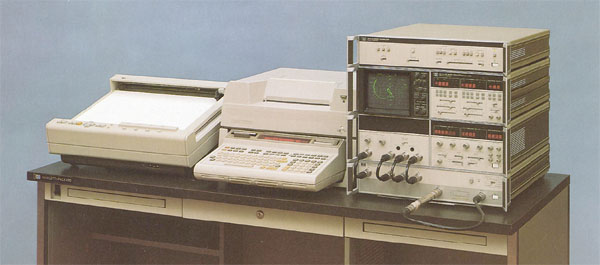 |
HP 8507B Automatic Network Analyzer (500 kHz to 1.3 GHz)
Photo from the HP Santa Rosa Division, 1979 Calendar - Courtesy of the Hewlett Packard Company |
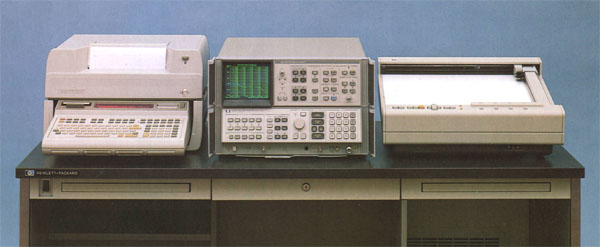 |
HP 8581A Automatic Spectrum Analyzer (100 Hz to 1.5 GHz)
Photo from the HP Santa Rosa Division, 1979 Calendar - Courtesy of the Hewlett Packard Company |
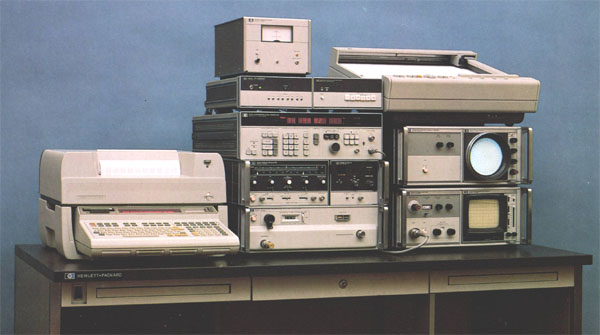 |
HP 8409A Semi-automatic Network Analyzer (110 MHz to 18 GHz)
Photo from the HP Santa Rosa Division, 1979 Calendar - Courtesy of the Hewlett Packard Company |
The HP 9845,
HP's High-end Technical Desktop Computer of the Ending 1970s
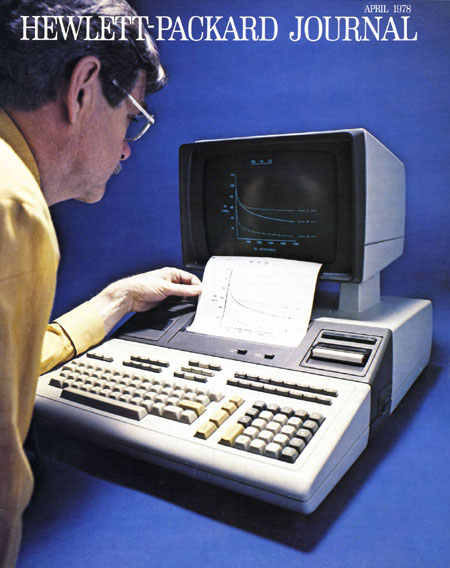 |
Cover of the April 1978 issue of the Hewlett Packard Journal
Courtesy of the Hewlett Packard Company |
Ten years after the first desktop, the HP 9845A was introduced in 1978 as the new flagship of the HP 9800 Series, integrating the most powerful central processor and the largest built-in mass storage system ever offered in a desktop computer. It also had a 12 inch CRT display, a BASIC interpretive language, and an optional graphics package with high-speed hard-copy output. The 9845A came standard with a built-in mini-cartridge tape drive (217K capacity). A second tape drive was optional as was a built-in thermal printer (80 characters wide, 480 lines per minute with graphics capability).
The 9845A had four I/O slots in which could accept the same interfaces as the HP 9825. The 9845A was shipped with 13K RAM standard, expandable to 62K. A "B" version replaced the 9845A in 1979. The original 9845B came standard with 56K RAM, expandable to 449K.
. . . And then came the HP 9845C
The HP 9845C,
The Beginning of the Color Graphics Workstations Race
The 9845C was introduced in 1980, and was the first computer from HP with a color graphics screen. This will mark the start of 20 years of competition between a growing number of computer graphics manufacturers. This was also the start of a new industry finding applications in every industry, and even more in everyday human activities.
Graphics and Color are by far the most spectacular results of a computer's complex calculation. They are also the most "human readable" illustration of every physical phenomena. The degree to which a computer could display results with colored graphics was immediatety considered as a measure of its performance. Graphics as a display of a computer's power soon became the main argument in marketing competition. We know, thirty years later, what became computer graphics power. 3D simulation, virtual reality, movie special effects are every day experiences.
Back to 1980, with the introduction of the 9845C: The future was in the capability leap of the color graphics capability, and was already pointed out in the Hewlett Packard Journal:
"With color, a wide range of new problems can be addressed. In mechanical design, for example, high-speed performance of a machine can be simulated, with different colors showing degrees of stress or various modes and frequencies of vibration. Manufacturing processes can be modeled, with color showing operational status and problem areas. An engineer can use the color display to visualize radio wave patterns around antennas, and a meteorologist can study weather patterns and the dispersion of pollutants or acid rain. In motion-picture production, a color graphics computer like System 45C can serve as an electronic storyboard, simulating complex animation and special effects before any film is shot. We've chosen to illustrate this application on our cover, and we thank Lucasfilm, Ltd. for the background shot."
A clear sign of things to come . . .
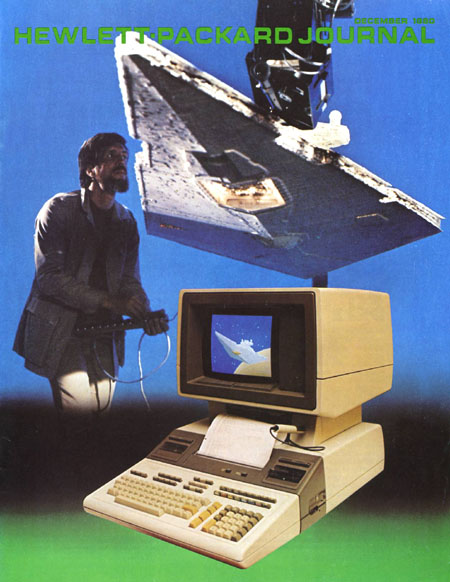 |
Cover of the December 1980 issue of the Hewlett Packard Journal
Courtesy of the Hewlett Packard Company |
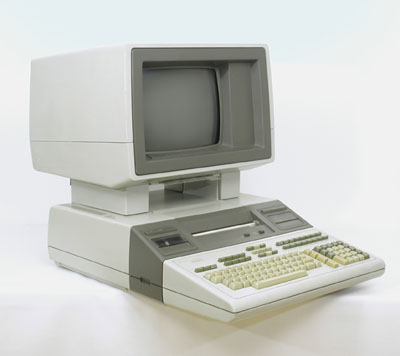 |
The HP 9845C
|
The HP 9845C
The Model 9845C, was a completely integrated color-graphics computer system. It featured a high-quality color display, a 9845T mainframe with dual tape transports, 187K-byte read/ write memory, and a high-speed thermal line printer. A new extended BASIC-language statements in 48K bytes of ROM provided easy access to the graphics capabilities of the color CRT.
The development of the System 45C was heavily influenced by 9845A/B customers using the optional graphics capability. Strong interest in the performance of the CRT display indicated a need for greater information density and faster display rates.
The high-resolution display area (560 by 455 pixels) is perfectly visible in ambient lighting. Eight colors are available for the alphanumeric display and an extensive range of colors (4,913 "eye-averaged" shades) is available for graphics images.
The 9845 was HP's number one revenue producing product in fiscal year 1980. In 1978 and 1979, the other previous versions of the HP 9845 had also been one of the company's top five products.
For all those who share the fascination for one of the first workstations ever, the HP 9845 Project Web Site managed by Ansgar Kueckes is the place to go.
Coming Next, The HP 85, The Fourth Generation.
A Personnal Computer, before the PC
The HP 85 was the first HP computer having every characteristics of a "PC". Even though introduced in 1979, two years before the IBM PC, the important part of the Series 80 life will take place during the early 1980s. Many devices from the series 80 are included in the collection (just a small sample is shown on the photo below). A large number of accessories, including ROMs, adapters, interface modules and application programs and documentations are also, still in working condition, in the collection. We will describe these various showpieces in the dedicated chapter of the next periode, 1980 to 2000.
If you have a particular interest in the HP 80 series, we highly recommend a visit to Vassilis Prevelakis' Web site. The "HP 80 Series Web Site" offers a download service containing a huge quantity of original HP 80 software and documentation. It is a great contribution to the HP, computer collectors, community.
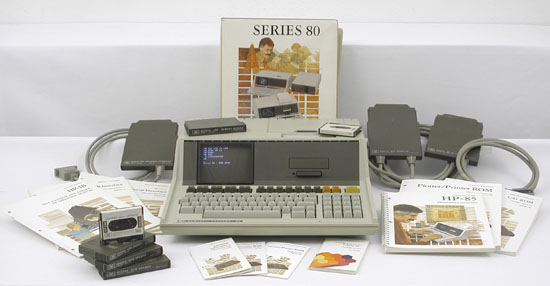 |
| A Small Sample of the Series 80 Computer, in the HP Memory Project Collection |
And a Lot More Computers Will Follow . . .
. . . And the story will be continued in various chapters dedicated to the 1980-2000 period.


